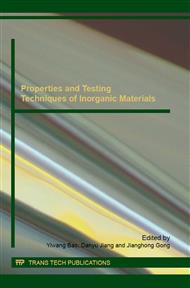p.289
p.293
p.297
p.301
p.306
p.311
p.315
p.323
p.327
Preparation and Performance of Inorganic Thermal Insulation Glazed Hollow Bead Material
Abstract:
Glazed hollow bead, a kind of inorganic lightweight aggregate that has been recently developed, has raised high concern in the field of thermal insulation of building wall due to its low thermal conductivity, low water absorption, good fireproof performance and relatively high compression strength. In this paper, the preparation of this thermal insulation glazed hollow bead material was introduced in detail, the influence of the amount of gel material on bulk density, porosity, thermal conductivity, compression strength of the thermal insulation glazed hollow bead material was investigated, the surface morphology and surface components were characterized by means of SEM and EDS. Results showed that the density, thermal conductivity and compression strength increased while the porosity decreased with the amount of gel material increasing. Appropriate temperature enables gel material to work at optimal level under which the compression strength increases, on the other hand, the porosity also increases, therefore, the thermal conductivity decreases.
Info:
Periodical:
Pages:
306-310
Citation:
Online since:
February 2016
Authors:
Price:
Сopyright:
© 2016 Trans Tech Publications Ltd. All Rights Reserved
Share:
Citation:


